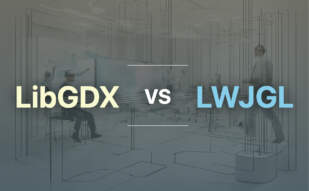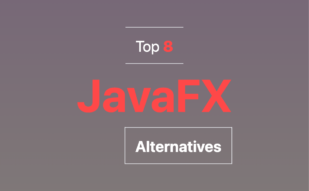LWJGL is a lightweight Java Game Library providing efficient cross-platform support for game and multimedia creation. Developed by Caspian Prince and Ioannis Tsakpinis, LWJGL offers low-level access to a range of technologies including OpenGL, OpenCL, and OpenAL. Its versatility has made it a foundational tool for popular Java game engines like libGDX and jMonkeyEngine.
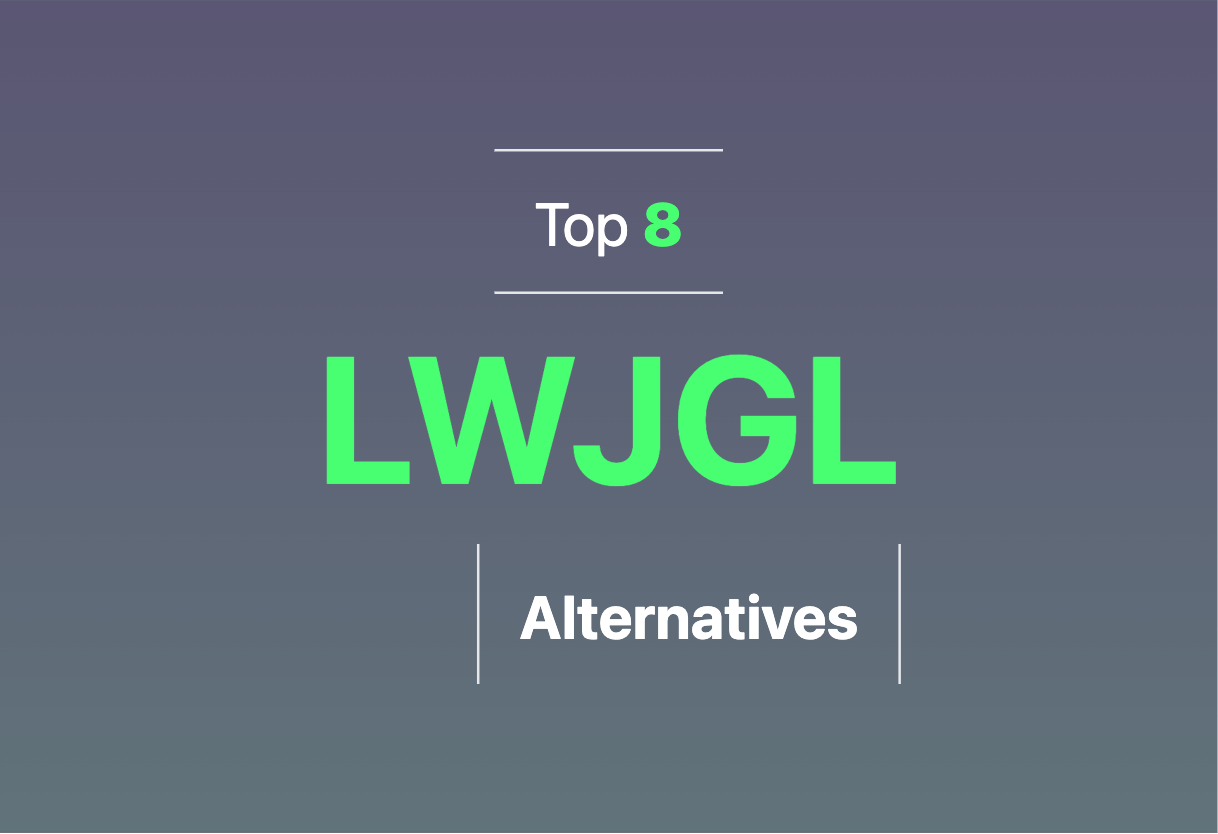
Exploring alternatives to LWJGL leads to options such as LibGDX, jMonkeyEngine, JavaFX, MonoGame, SDL2, Pygame, Unity, Love2D, and more.
LibGDX
Integrating state-of-the-art software technology and community know-how, LibGDX is a free, Java-based game development framework, expertly created for cross-platform targeting. Its practicality and versatility are proven by its decade-long existence and the reliable foundation underpinning its design.
LibGDX Top Features
- Unified API enabling cross-platform development targeting Windows, Linux, macOS, Android, iOS, and the Web.
- Extensive Graphics Features such as vertex arrays, textures, framebuffer objects, shaders, simple shape rendering, and support for OpenGL ES 2.0/3.0 rendering.
- Integral Input Handling for mouse, keyboard, touchscreen, controllers, accelerometer, gyroscope, and compass, supported by gesture detection (taps, panning, flinging, and pinch zooming).
- Easy Third-Party Integrations like Google Play Games, Apple Game Center, AdMob, firebase, and Facebook’s Graph API.
- Advanced 2D and 3D Physics Features including Box2D physics, Bullet physics, and support for Wavefront OBJ and MD5.
| Audio Streaming | Excellent audio support for formats including WAV, MP3, and OGG. Additionally, LibGDX accommodates direct PCM sample playback and recording. |
| Open Source | As an open source project under the Apache 2.0 license, LibGDX invites contributions from its vast community of developers. |
| Excellent Community Support | Access to a large, active community via forums and an active Discord server, alongside comprehensive Wiki tutorials for novice and experienced developers alike. |
LibGDX Limitations
- Being a code-centric framework, beginners may find the fine-grained control challenging
- The learning curve can be steep for non-Java developers.
LibGDK Pricing
One of the biggest advantages of LibGDX is that it’s completely free to use, being generously licensed under the Apache 2.0 license.
LibGDX Use Cases
Use case 1
LibGDX is a fantastic choice for independent game developers wanting fine-grained control over every aspect of game design and behaviour, while ensuring their game is compatible with the majority of platforms.
Use case 2
For educational institutions teaching Java game development, LibGDX serves as a practical, real-world tool for developing cross-platform games with good community support.
Use case 3
Coding bootcamps and online courses focused on game development can leverage LibGDX’s extensive features and documentation to provide in-depth, hands-on training for their students
jMonkeyEngine
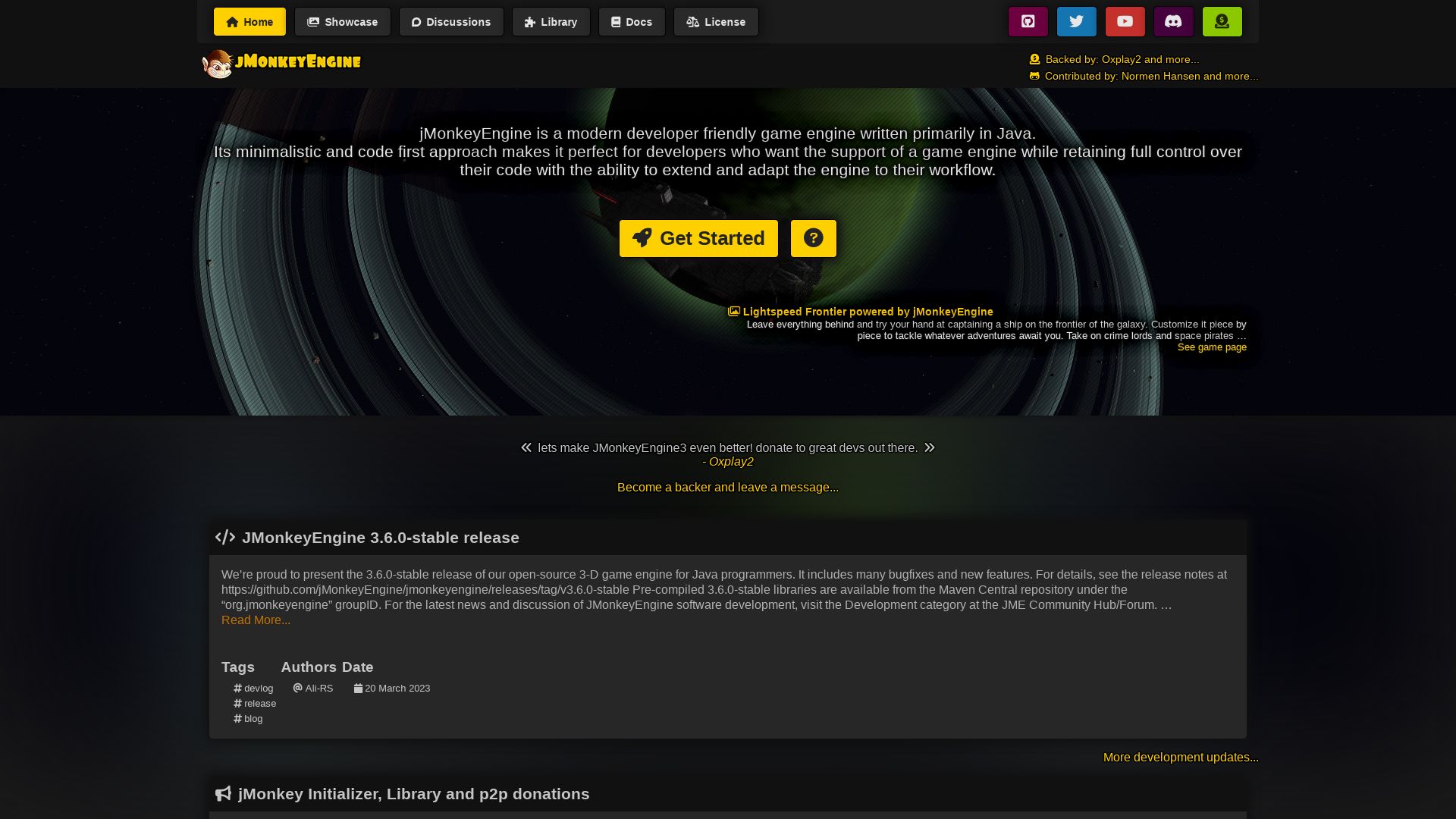
An intriguing alternative to LWJGL is jMonkeyEngine, a Java-based game engine that supports cross-platform compatibility. With its minimalist, code-first approach, it primarily caters to developers aiming to create high-quality games.
jMonkeyEngine Top Features
- Open-sourced: jMonkeyEngine follows a permissive BSD 3-Clause license, promoting free and easy use.
- Multiple GUI options: With Lemur, Nifty GUI, and IGUI among others, developers can optimally design their game interface.
- Cross-platform compatibility: jMonkeyEngine is compatible with PC, Linux, iOS, Android, and Mac, offering broad reach.
- Advanced post-processing: The engine supports post-processing out of the box with filters like Bloom FXAA and Light Scattering.
- Community-led development: A community of active programmers supports and updates it, benefiting from a wealth of shared knowledge and tools.
| Feature | Description |
|---|---|
| 3D audio support | Enhanced sound effects via OpenAL and jmePhonon for immersive gaming experience. |
| Physics solutions | Supports multiple solutions including jBullet and Minie, allowing realistic animation and motion. |
| Domain in gaming education programs | jMonkeyEngine is a preferred tool in game-education programs for learners of all age groups. |
jMonkeyEngine Downsides
- Despite its adaptability, jMonkeyEngine has its limitations, notably lacking some advanced features found in larger engines like Unity.
- Being a lower-level game development tool, it requires a larger amount of manual coding compared to some other engines.
jMonkeyEngine Pricing
jMonkeyEngine is free to use, following an open-source model under a permissive BSD 3-Clause license.
jMonkeyEngine Use Cases
Use case 1
Those developing RPG games, like Mythruna, can leverage jMonkeyEngine’s advanced particle capabilities for game customization.
Use case 2
jMonkeyEngine is highly beneficial for those aiming for cross-platform game deployment due to its compatibility with multiple systems.
Use case 3
The engine serves as a valuable teaching aid in game development education programs due to its beginner-friendly design and superior adaptability.
JavaFX

Tap into the power of JavaFX, a leading graphics/media library, designed to help developers design, create, test, and deploy rich client applications. Its cross-platform compatibility and full integration with Java SE 7 ensure consistency and ease across diverse platforms.
JavaFX Top Features
- Rich Integration: Fully integrated with Java SE 7 JRE and JDK.
- Fully Customizable: Applications can be tailored using CSS and segregated from implementation.
- Robust API: Boasts of Java APIs, FXML, Swing interoperability and more.
- Extensive Range: Offers a wide feature-set for developing GUIs, supporting CSS, 2D and 3D Graphics, WebView etc.
- Regular Updates: Ensures currency and smooth operations with regular updates, patches, and bug fixes.
| Feature | Description |
|---|---|
| Native System Capabilities | Enables access to the system’s foundational capacities. |
| Scene Builder | Out-of-the-box tool for intuitively managing layouts. |
| Community Support | An open-source platform with robust Java community backing. |
JavaFX Limitations
- Doesn’t have as much of a broad third-party ecosystem as some other engines.
- While it has a short learning curve for Java developers, those unfamiliar may face initial catches in comprehending the system.
JavaFX Pricing
Free. As an open-source platform, JavaFX is free to download and use.
JavaFX Use Cases
Use Case 1: Desktop Development
JavaFX is beneficial for desktop development with its advanced GUI capabilities, high performance, and top-notch reliability.
Use Case 2: Network-aware Applications
JavaFX excels in creating network-aware applications that can be deployed across multiple platforms.
Use Case 3: Mobile and Embedded Devices
It’s compatible cross-platform approach makes JavaFX a good choice for development on mobile and embedded devices, like Raspberry Pi.
MonoGame

An exciting venture into the world of game development, MonoGame is a free, open-source, C# framework cherished by developers. Originally released in 2009, MonoGame became renowned for its versatility across multiple platforms and its maintenance of Microsoft XNA 4 API.
MonoGame Top Features
- Openness: As an open source platform, MonoGame encourages developers to contribute their knowledge and improve it.
- Multi-platform compatibility: MonoGame supports a wide array of platforms including iOS, Android, macOS, Linux, PlayStation 4, and Nintendo Switch.
- Community Support: With robust community support and maintenance, users have access to a reliable pool of resources and help.
- C# focus: MonoGame maintains a focus on lower-level programming with C#, offering developers complete control over their development process.
| Feature | Description |
|---|---|
| Content Management | Adheres to XNA 4 ContentManager model, providing a clean, organized system for handling game data. |
| Extended Capability | Although initially built for 2D projects, MonoGame has since expanded its functionality to support 3D development. |
| Educational Resources | Offers courses, tutorials and game schooling to beginners and aspiring developers. |
MonoGame Limitations
- It’s not suitable for developers who prefer a WYSIWYG environment or integrated game editor.
- For iOS and Android, paid support is needed.
- Were initially solely for 2D games, although 3D support has been added.
- The XNA framework it uses is outdated and not optimized for non-Windows platforms.
MonoGame Pricing
One of the best aspects of MonoGame is that it’s completely free. It’s an open-source platform inviting all to explore the world of game development.
MonoGame Use Cases
Use case 1
MonoGame serves as an excellent resource for indie game developers, offering lower-level programming control and extensive multi-platform support. Notable games, such as Bastion and Celeste, have been developed using this framework.
Use case 2
For those eager to learn about game development, MonoGame provides a comprehensive set of education resources including C# courses, math lessons, and computer graphics tutorials.
Use case 3
Developers wanting to transition their games to different platforms can benefit from MonoGame’s multi-platform compatibility.
SDL2
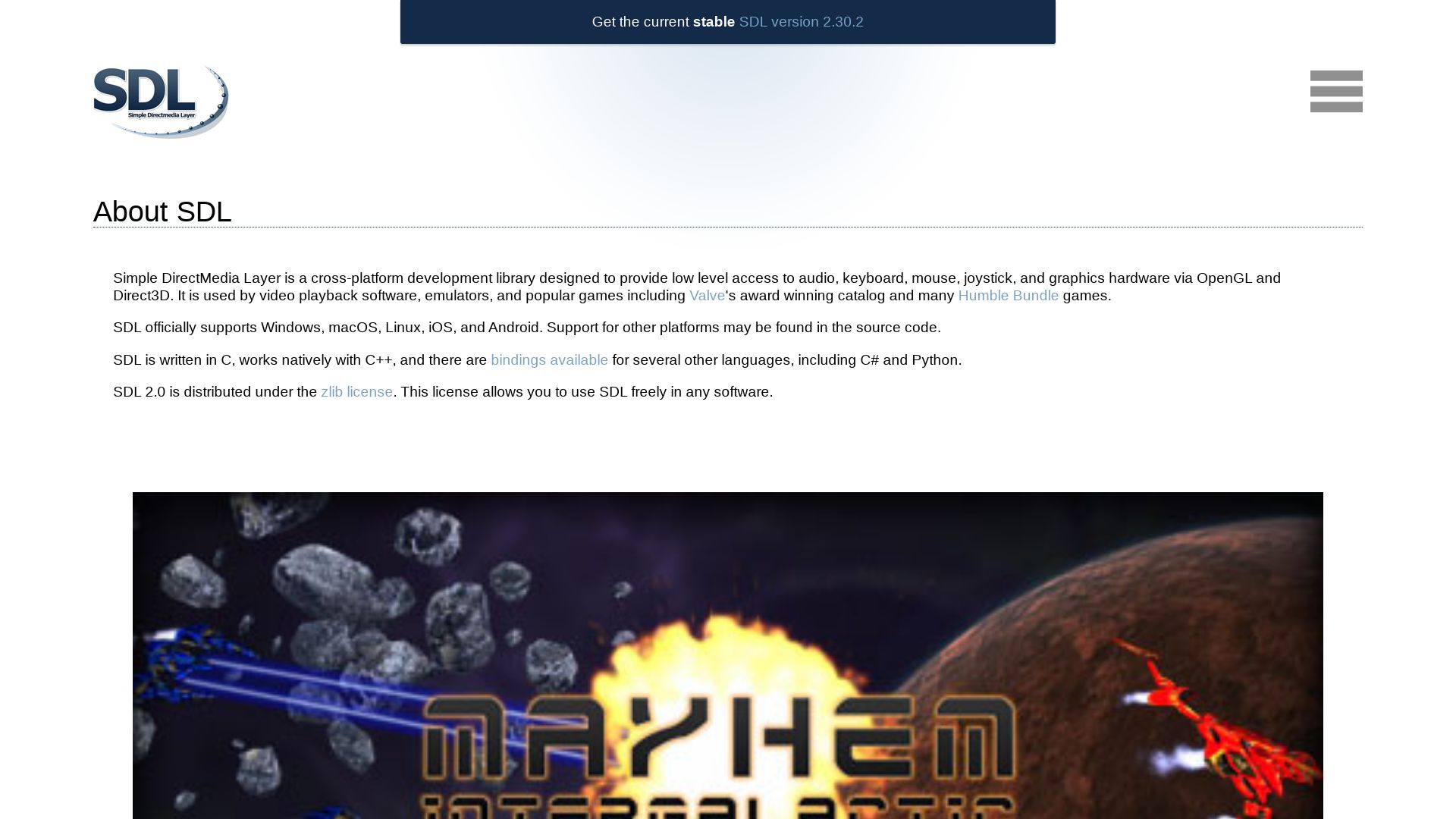
Delving into the realm of game development, we come across SDL2, or Simple DirectMedia Layer, a dynamic library dedicated to hardware-accelerated 2D rendering and other essential game development features. Designed to serve as a low-level audio, keyboard, mouse, and touchscreen library, SDL2 offers a remarkable platform for developing games on diverse platforms.
SDL2 Top Features
- Hardware Accelerated 2D Rendering: Leveraging the power of your hardware for high-speed, efficient 2D game development.
- Comprehensive Controller Integration: SDL2 supports a wide range of controllers, including keyboards, mice, touchscreens, and more, leading to intensive player engagement.
- TrueType Fonts: Rendering aesthetically pleasing texts, SDL2 allows the integration of stylish TrueType Fonts in your games.
| Resources for Learning: | The “SDL Game Development” by Shaun Mitchell, “Programming Linux Games” by Loki Software, and multiple online tutorials offer insightful guidance to aspiring game developers. |
| Frameworks: | The library also provides frameworks for handling user inputs and creating 2D maps with tiles, making it suitable for diverse game genres. |
SDL2 Limitations
- The initial efforts in working with SDL2 might be challenging due to wrapper code adjustments and the application of advanced features like pathfinding algorithms.
- While SDL2 is excellent for 2D game creation, it requires SDL compatibility with OpenGL for 3D game programming, limiting its out-of-the-box 3D game development potential.
SDL2 Use Cases
Use Case 1: Efficient Game Programming on Non-Powerful Machines
SDL2 demonstrates its efficacy in resource-constrained environments by enabling robust game programming even on relatively weaker machines like a 2010 Intel Atom netbook.
Use Case 2: Game Save Data Encryption
With SDL2, game developers can ensure the security of their user’s game save data by harnessing its potential for encryption, even with a simple XOR operation.
Use Case 3: Variety in Game Genre Development
The versatility of SDL2 resonates in its abilities to support the creation of 2D maps with tiles, opening avenues for developers to explore various game genres.
Pygame

Enter the world of Pygame, a collection of Python modules, specifically crafted for creating video games. Its roots can be traced back to October 28, 2000, an initiative by Python enthusiasts like Lenard Lindstrom, René Dudfield, Pete Shinners, and more. Today, it leverages the power of Python, C, Cython, and Assembly, aiming to democratize video game development by offering easy and accessible resources.
Pygame Top Features
- Cross-platform functionality: Compatible with different operating systems.
- Community-driven development: A plethora of community-drafted tutorials available.
- Portability: Runs on handheld devices, game consoles, and even OLPC computers.
- Control over game speed: The FPS can be adjusted to match the preferred speed of the game.
Pygame Limitations
No significant disadvantages have surfaced to challenge the expanding popularity and utility of Pygame. Its constant evolution, driven by a lively community and dedicated developers, ensures it remains a robust choice.
Pygame Pricing
Emulating the spirit of democratized learning, Pygame is free and open-source, making it an advantageous choice for all.
Pygame Use Cases
Use case 1 – Beginners
Its simplified approach makes Pygame an excellent choice for first-time programmers and those still learning the ropes of game development.
Use case 2 – Classrooms
From educating young children to supporting college students’ complex projects, Pygame serves as an instructional tool, promoting a deep understanding of game development.
Use case 3 – Indie Developers
With a rich history of games like Frets on Fire and Drawn Down Abyss, Pygame has established itself as an ideal tool for independent developers seeking to make their mark in the gaming industry.
| Extra Features | Benefits |
|---|---|
| Simple DirectMedia Layer (SDL) library utilization | Simplifies real-time game development |
| Support for different formats | Allows creation of open-source, freeware, shareware, or commercial games |
| Android compatibility | Expanded reach across various Android devices, offering sound, vibration, keyboard, and accelerometer support |
Unity

An undisputed titan in the game development field, Unity has powered creative 3D and 2D games since 2005 with its versatile engine compatible with multiple operating systems and platforms including AR applications.
Unity Top Features
- Cross-Platform Support: Empowering developers to launch games on Android, iOS, and beyond.
- Wide Range of Applications: From AR marvels to immersive 3D simulations, Unity facilitates it all.
- Diverse Coding Languages: Supporting BOO script, Javascript, and C#, Unity broadens developers’ toolkit.
- Rich Asset Store: Dive into an expansive collection of pre-designed textures and features to amplify your game designs.
- Active Community: Benefit from a bustling hive of developers willing to assist, discuss, and improve the Unity ecosystem.
| Stringent Fraud Detection | A future-proof initiative to protect developers from incurring pirated copies’ costs. |
| Higher Fees in “Standard” Markets | The pricing model scales fees higher in more established markets like the US and UK than emerging territories such as India and China. |
| Free and Premium Versions | The freedom to choose between versions to match individual developer needs and budgets. |
Unity Downsides
- Potential Revenue Hampering: Upcoming Unity fees could strain digital preservation endeavors.
- Financial Stability: Developers fear unanticipated pricing shifts may sacrifice their monetary sustainability.
- Diminished User Trust: Unannounced changes have driven a rift between Unity and its users.
Unity Pricing
Unity embarks on a new pricing journey on January 1, 2024. While aiming to safeguard developers from costs linked to pirated installations, Unity has assuaged concerns by clarifying that no install fee will be levied until a game generates $200,000 in earnings and surpasses 200,000 installations.
Unity Use Cases
Use case 1: AR Game Creation
Unity shines brightly, offering tools and functionalities for creating captivating AR games, amplifying the immersion and player engagement levels.
Use case 2: 3D Simulation
The capability to weave intricate 3D simulations has seen Unity become a mainstay for developers seeking high-quality, immersive experiences.
Use case 3: Indie Game Development
For independent game creators, Unity is a haven that offers a host of tools, features, and an inspiring community to help bring unique game concepts to life.
Love2D
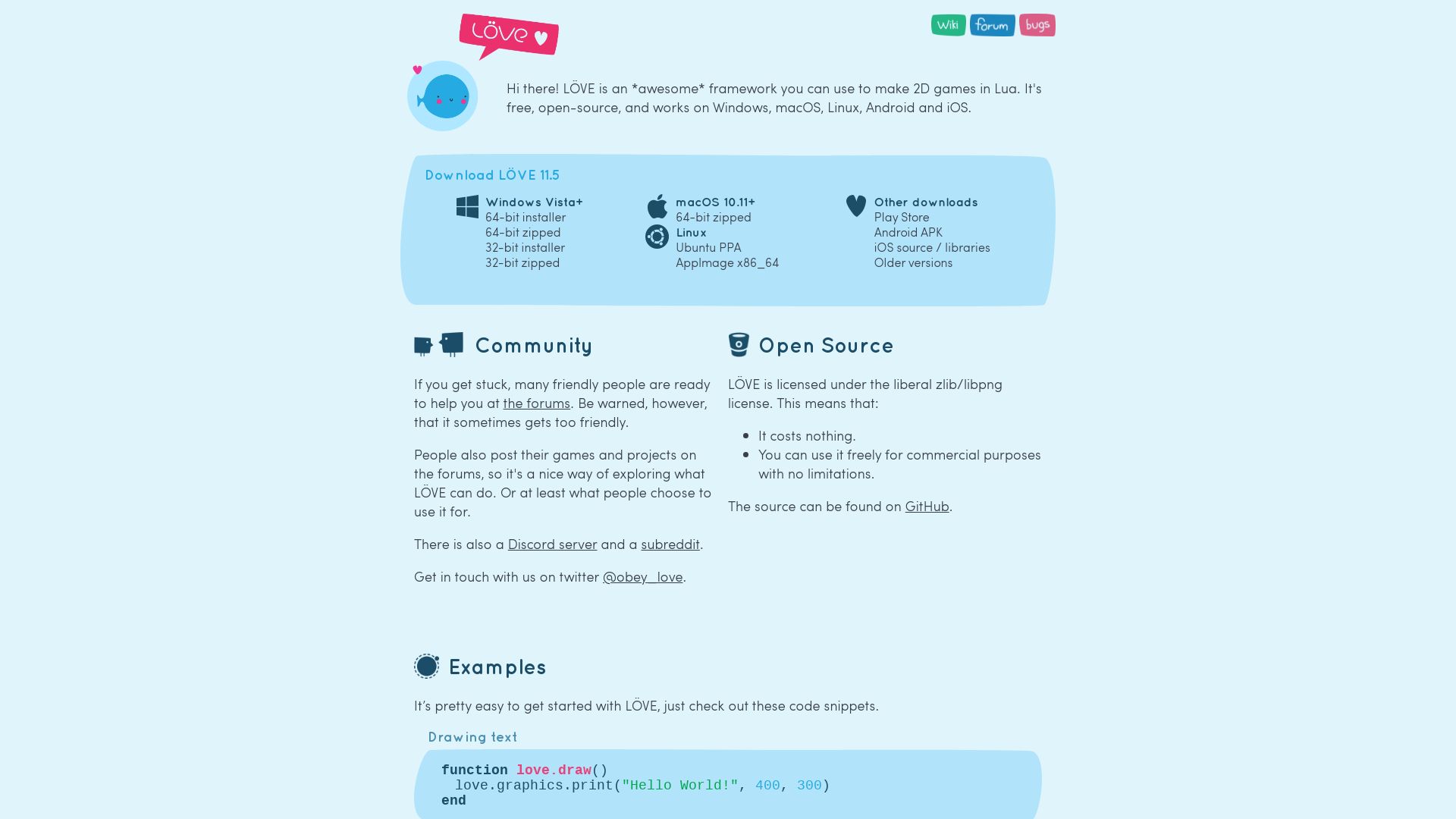
Love2D, an open-source 2D game development engine, was birthed back in 2008. Conveniently cross-compatible with multiple platforms, it leverages C++ and loves Lua script. Its strength lies in game-development contests like Ludum Dare and is proven by popular games like Move or Die and Mari0.
Love2D Top Features
- Supports an array of audio and image formats (WAV, OGG, MP3, PNG, JPEG, GIF, TGA, BMP).
- Integrates with SDL and OpenGL libraries.
- Adopts the FreeType engine for font rendering.
- Enables openGL pixel shaders and touch controls for mobile devices.
- Includes Box2D physics engine and LuaSocket library for network communications.
- Additional flavours like piLöve crafted for Raspberry Pi, with related forks and libraries.
| Top Forks/Libraries | Simple Tiled Implementation library, anim8 library |
| Implementations of Love2D | LIKO-12, Lutro, ChaiLove, love.js |
| Support | A vibrant community via Discord server, IRC channel, and issue tracker |
Love2D Downsides
- Limited to 2D game development.
- No guarantee that games will work across different LÖVE versions.
- Power and feature limitations compared to Unreal, Unity.
- No graphical interface provision.
Love2D Pricing
Pride comes without a price tag. Published under the zlib License, Love2D is open-source and available for free.
Love2D Use Cases
Use case 1
Love2D shines bright in game development competitions. The Lua scripting language and additional libraries give a competitive edge to thrive in tight contests like Ludum Dare.
Use case 2
Remodel iconic games or develop your dream 2D game. Ably supported with Move or Die, Mari0 and more, Love2D is a forte for game enthusiasts.
Use case 3
For those looking for some open-source flavour, Love2D serves the best dish. With an active community, resources like code snippets make it a hot pick for any solo developer or small team.
Hannah Stewart
Content writer @ Aircada, tech enthusiast, metaverse explorer, and coffee addict. Weaving stories in digital realms.



